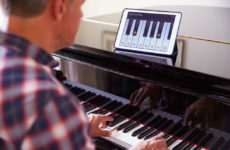
If you’re curious about learning how to play keyboard, then you have a very exciting musical journey ahead of you. You’ll want to make sure you do things right, though, because it’s easy to get into some bad habits that can stick around throughout your musical career.
The keyboard is a very popular, very interesting, and very beautiful instrument. The keyboard’s roots trace back thousands of years through the piano, and the fact that we’re still playing – essentially – the same instrument this long after its discovery, is a testament to how amazing the instrument is.
What should I know before playing keyboard?
The keyboard, unlike its predecessor, is played using electricity. The operation of the keyboard is quite similar to a piano – you strike the keys with your fingers, which triggers a button or sensor, and the sensor tells the keyboard which sound to produce.
Learning how to play keyboard gets a bit more complicated than that, though, once you start throwing chords, melodies, and rhythms into the mix. Before you learn any of that, though, it’s important to understand a few things before you even attempt to play the keyboard.
Hand position.
Hand position is very crucial for playing keyboard – if you start playing keyboard without learning the proper hand position, you’ll develop some bad habits that could lead you to getting injuries like carpal tunnel syndrome.
- Your hands should be resting so your wrists are straight and your fingers are not curled. Repetitively curling your fingers degrades the tendons quickly and will reduce your mobility.
- You should press the keyboard with your fingers kept as flat and straight as possible.
Posture.
Posture is also very important for keyboard players. It’s possible for keyboard players to develop long-lasting posture issues just from sitting at a keyboard improperly for hours a day.
- You should make sure your back is straight and your feet are planted firmly on the floor.
You’ve probably seen a keyboard and know what its layout looks like. The keyboard is laid out in a very convenient style for pianists and for instructors, which make it a great device for teaching and learning.
- The keys are laid out in a way that’s appealing visually, allowing the player to separate and identify different notes just by looking at the keyboard. The white keys indicate normal notes, and the black keys indicate sharps and flats.
- This way, it’s extremely easy for teachers to explain the intervals between musical scales, or to teach aspiring players where the notes in scales lie, or how to break up chords.
The basics of how to play keyboard
The keyboard can be a very complicated instrument, depending on how deep you delve into learning how to play it. You can compose and play exquisite symphonies, or recreate Bach’s epic musical compositions.
Regardless of what you choose to do, you’ll need to start by learning the basics.
Notes
There are 12 notes on the keyboard, despite how many keys you see. These notes are
A, A sharp, B, C, C sharp, D, D Sher, E, F, F Sharp, G, and G Sharp
The farthest left note on the keyboard is typically a C. We’ve explained already that the black keys are the sharps or flats – you can figure out where the notes lie from thereon.
What’s a flat?
A flat note is basically the same as a sharp note, except that ti comes before the major note instead of after. If we looked at the same keyboard using flats instead of sharps, would see:
A, B Flat, B, C, D flat, D, E flat, E, F, G flat, G, A Flat
You may notice certain notes don’t have sharps or flats, and that’s because of something we’ll look at next.
Scales
Scales are sets of notes at set intervals that harmonize together to sound nice. The major scale that we use in the west is organized in such a way that there is no “half-step” (a phrase used to describe an interval between notes) between the B and C notes, and none between the E and F. That’s why there’s no B sharp or E sharp.
Major scales are 8 notes and follow a scale of step, step, half-step, step, step, step, half-step.
A step is the distance of two half-steps, and a half step is an increase of a one-note interval, for example, from A to B-Flat.
Following this formula to get an A-Major scale, we find:
A, B, C Sharp, D, E, F sharp, G Sharp, A
This formula can be applied to any note to find its major scale.
You can also use scales to find chords. To find a major chord, take the first, third, and fifth note out of a scale. For example, to find an A Major Chord, you take your A, C Sharp, and E from the scale above and play them all together.
In conclusion
Playing keyboard can be very complicated, but it doesn’t have to be. If you make sure to get quality keyboard lessons, you’ll learn in no time.
There’s an endless amount of information to learn about the keyboard, but this just means you can keep improving your technique for years!


